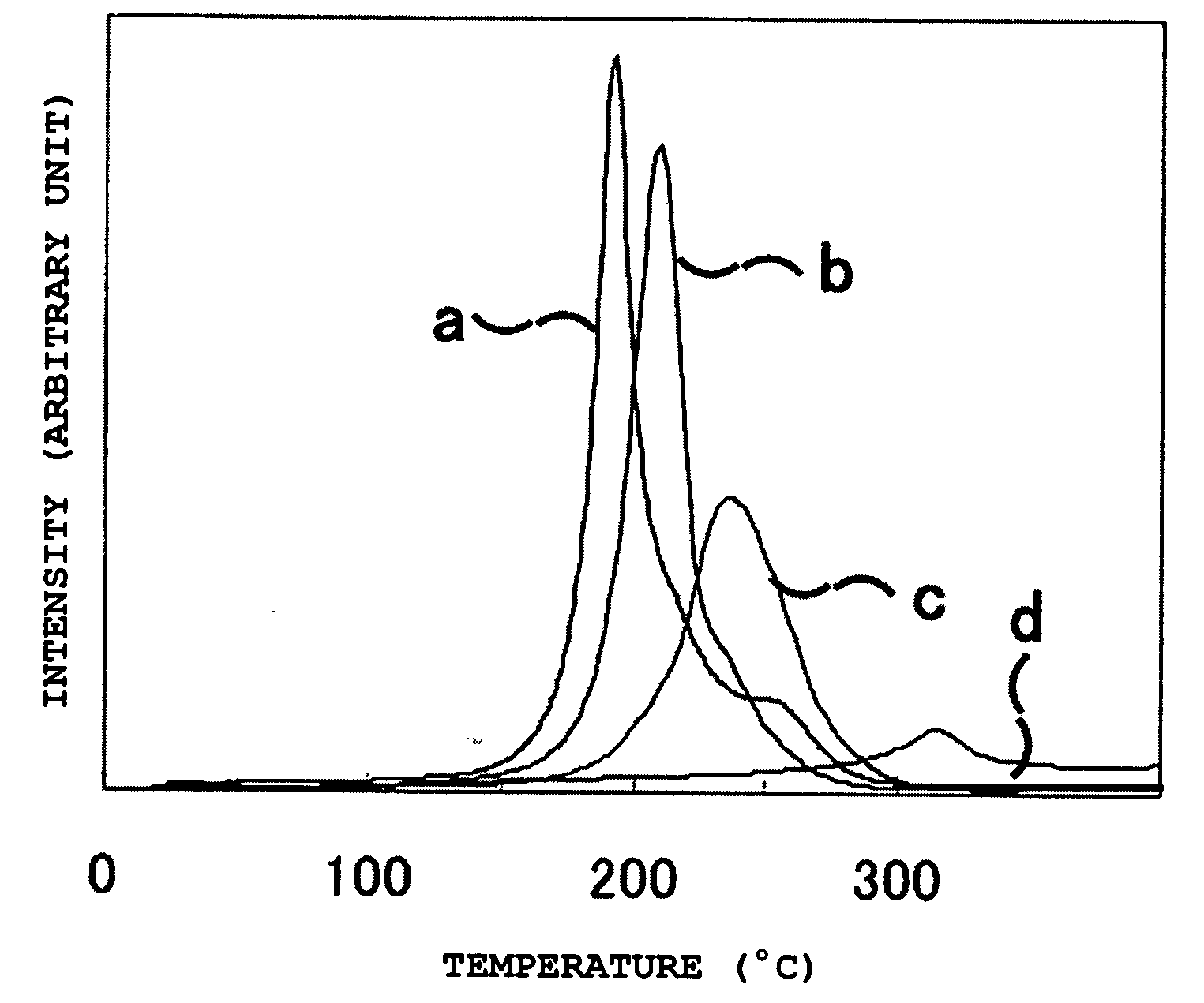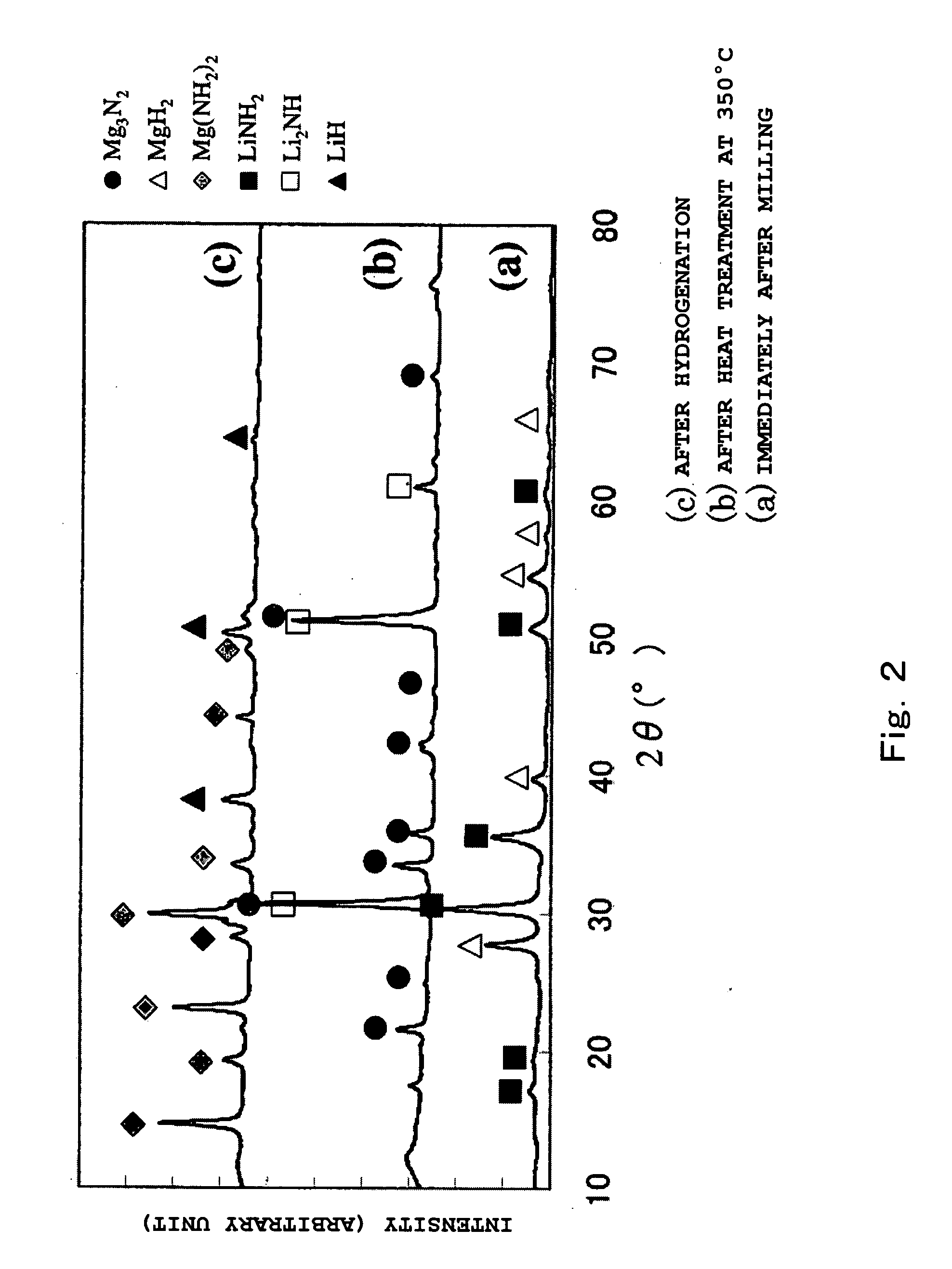Hydrogen storage material and method for manufacturing same
a technology of hydrogen storage material and hydrogen release, which is applied in the direction of chemistry apparatus and processes, other chemical processes, explosives, etc., can solve the problems of high hydrogen release start temperature and high hydrogen release peak temperature, and achieve the effect of reducing hydrogen generation temperature and hydrogen release peak temperatur
- Summary
- Abstract
- Description
- Claims
- Application Information
AI Technical Summary
Benefits of technology
Problems solved by technology
Method used
Image
Examples
examples
[0063]The Examples and the Comparative Examples of the present invention will be described below.
[0064](Preparation of Magnesium Amide)
[0065]Magnesium amide (Mg(NH2)2) was prepared by the following procedure. One gram of magnesium hydride (MgH2) was put in a mill vessel made of high Cr steel, (250 ml of capacity), in a gloved box under a high purity argon atmosphere. The space in the mill vessel was evacuated. After introducing a specified amount of ammonia gas into the mill vessel to at or larger than the molar quantity of the formula (15), the vessel was sealed. Then, the mill vessel was subjected to milling at room temperature and under atmospheric pressure for a specified time under a condition of 250 rpm, thereby prepared the magnesium amide (Mg(NH2)2). The reacted gas in the mill vessel after the milling was analyzed to determine the amount of hydrogen and analyzed by XRD to confirm the formation of various metal amides. The raw materials used in the present invention are list...
examples 1 to 7
[0066]Table 2 shows the compositions of starting materials used in Examples 1 to 7 and Comparative Examples 1 and 2, which are described below. The respective raw materials selected from the group consisting of lithium hydride (LiH), magnesium hydride (MgH2), lithium amide (LiNH2), and magnesium amide (Mg(NH2)2) were weighed in a high purity argon gloved box so as the mixture to contain two kinds of metal elements and to give the composition shown in Table 2, and so as the amount of titanium trichloride (TiCl3) to become 1.0% by mole to the total moles of the metal components in the starting materials, and then were charged in a mill vessel made of high Cr steel equipped with a valve. After evacuating the space in the mill vessel, high purity hydrogen gas was introduced into the mill vessel to 1 MPa. Then, the charged mixture in the mill vessel was subjected to milling in a planetary ball mill (P-5, manufactured by Fritsch GmbH) at room temperature and under atmospheric environment ...
example 8
[0067]In the above high purity argon gloved box, magnesium hydride (MgH2) and lithium amide (LiNH2) were weighed so as the mole ratio of them to become 3:8, and so as the total weight of them to become 1.3 g. They were subjected to milling in a similar procedure to that of Examples 1 to 7. After that, the prepared sample was transferred into a reactor with 30 cm3 of capacity in the high purity argon gloved box, which was then subjected to heat treatment in a vacuum at 250° C. and at 350° C. for 16 hours. Then, the sample was hydrogenated under a hydrogen pressure of 10 MPa at 200° C. for 12 hours.
PUM
 Login to View More
Login to View More Abstract
Description
Claims
Application Information
 Login to View More
Login to View More - R&D
- Intellectual Property
- Life Sciences
- Materials
- Tech Scout
- Unparalleled Data Quality
- Higher Quality Content
- 60% Fewer Hallucinations
Browse by: Latest US Patents, China's latest patents, Technical Efficacy Thesaurus, Application Domain, Technology Topic, Popular Technical Reports.
© 2025 PatSnap. All rights reserved.Legal|Privacy policy|Modern Slavery Act Transparency Statement|Sitemap|About US| Contact US: help@patsnap.com



